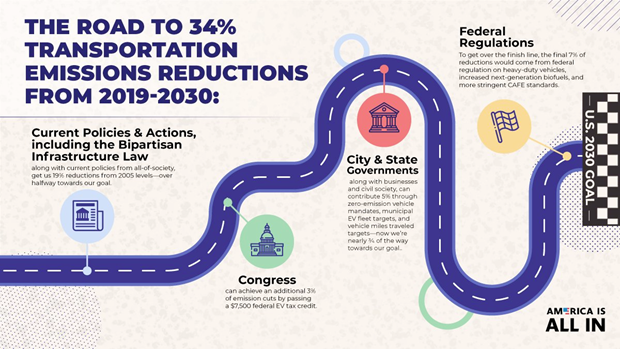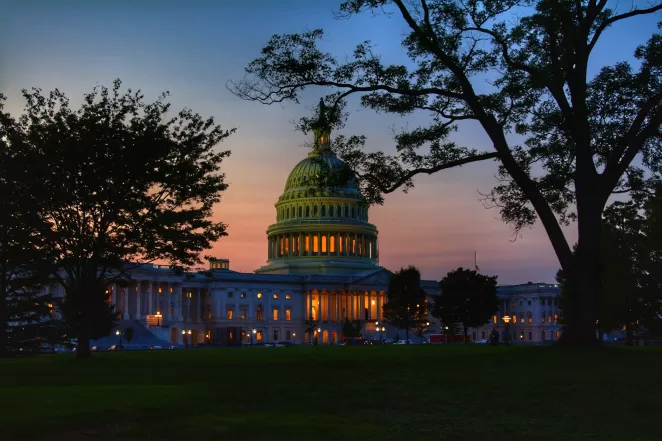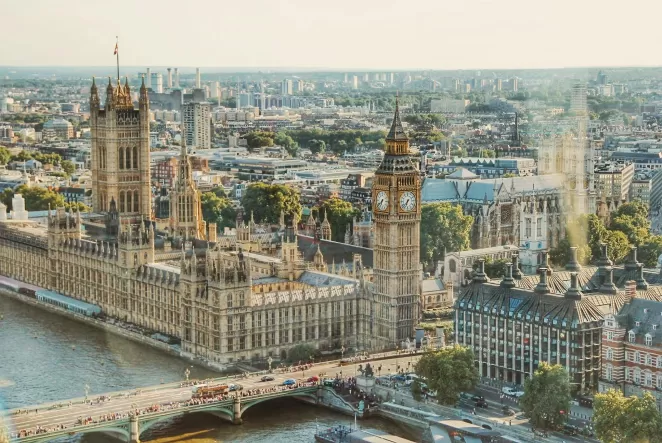Analysis: Public Overwhelmingly Supports Policy to Reduce Highway Emissions
Review of 100,000 public comments shows broad geographic support to track, reduce highway emissions
By Miguel Moravec, Courtney Bourgoin, and Beth Hartman

Right now, the Department of Transportation (DoT) is exploring an ambitious effort to set goals for reducing emissions from travel on US highways, requiring states and Metropolitan Planning Organizations (MPOs) to take action by reporting the amount of emissions generated by highway travel in their areas.
Experts say the proposed standard will be critical for improving transparency and ensuring policymakers have effective plans to reduce pollution and climate impacts when planning transportation infrastructure projects. While the rule does not necessarily influence how federal transportation infrastructure money will be spent, it does give states and localities the data to understand the climate and health benefits of certain projects over others.
New analysis from America Is All In shows that—of the 100,000 public comments on the proposal—99.9% of the comments were supportive of the strong standard. The public input reflects a strong desire from businesses, non-profits, local governments and individuals from all corners of the country to ensure that future transportation investments are made with sustainability in mind, especially now that billions of new dollars from the Bipartisan Infrastructure Law are on the way to help revitalize the nation’s aging roadways and infrastructure.
How did your community weigh in?
For the first time, data from the comment period was visualized using an interactive map. The results of this effort reveal that support for the rule transcends traditional political and geographical boundaries. Small businesses from Texas to Florida, for example, bucked the status quo and voiced their support for emissions transparency, underscoring that the policy will be beneficial for groups planning to capitalize on the forthcoming transition to safer, cleaner, and more equitable modes of travel.
The Problem and Solutions
According to the Environmental Protection Agency, transportation represented the largest sector of emissions in the United States in 2020. Recent analysis shows that emissions from this sector may either grow substantially or could shrink considerably based on what type of mobility projects are prioritized in the future. Spending the Bipartisan Infrastructure Law dollars on clean transportation projects-like train improvements, electric buses, and bike lanes-instead of highway expansion, for example, would slash climate emissions and keep us on track to meet national climate goals while also increasing mobility options for Americans.
 The need to improve the US transportation system extends beyond climate necessity, however. A 2021 report by the Brookings Institution made the financial case for modernizing our country’s infrastructure to keep markets equitable and dynamic. A 2022 study from the American Lung Association highlighted the health threat that comes from an overreliance on the automobile: vehicle smog endangered 137 million Americans last year alone. These economic and health burdens often disproportionately fall on communities of color, who are 61% more likely to live near air pollution and also three times less likely than white Americans to have access to a car.
The need to improve the US transportation system extends beyond climate necessity, however. A 2021 report by the Brookings Institution made the financial case for modernizing our country’s infrastructure to keep markets equitable and dynamic. A 2022 study from the American Lung Association highlighted the health threat that comes from an overreliance on the automobile: vehicle smog endangered 137 million Americans last year alone. These economic and health burdens often disproportionately fall on communities of color, who are 61% more likely to live near air pollution and also three times less likely than white Americans to have access to a car.
Fortunately, a report from the America is All In coalition shows that we have much better options for reducing mobility emissions than we did just a few years ago thanks to historic investments from the Bipartisan Infrastructure Law and the Inflation Reduction Act. A path forward to reach better climate, health, and infrastructure outcomes will require all levels of government and society to play a role in activating these funds, as illustrated in the the graphic below.

In the coming months, the DoT will make a critical choice: one that could be the difference between doing the work needed to build a stronger, healthier transportation system or one that could sidestep a critical part of reaching our climate commitments.
Equipped with the right data about the consequences of our choices, we can improve our transportation system in an informed, strategic way. It is precisely why so many Americans—representing themselves, businesses, non-profits, cities and states—weighed in to support the DoT's proposed reporting standard.
Breaking Down the Public Comments
1) State and Localities
A large majority of MPOs were in favor of the rule, and the state DoT's in favor of the framework represented tens of millions more Americans than the DoT's in opposition. In addition to increasing emissions transparency, the agencies agreed that the rule was consistent with local efforts to reduce climate change and to make our transportation infrastructure more resilient to extreme weather events.
All In found that:
- The 29 Metropolitan Planning Organizations (MPOs) and mayor's offices who wrote in support of the rule represent a population of 70 million American citizens.
- The 13 state DOTs who wrote in favor of the measure represent 121 million constituents.
- Many of these agencies noted that 24 states and DC already track GHG emissions with the goal of reducing them.
- Several states have implemented even stronger versions of the rule. Colorado recently passed an emissions tracking and reduction plan that shifted $1.5 billion away from highway expansions and into clean transit alternatives. Coloradans are jumping at the opportunity to access the new mobility options, including subsidized e-bikes and electric buses.
- In comparison, only 7 MPO’s representing a population of 3 million submitted comments asking the federal government to reconsider the rule, with 17 state departments of transportation representing 89 million constituents joining in the dissent.
2) Businesses and NGOs
Over 200 non-profit organizations and associations submitted comments about the rule, with the vast majority expressing support for the rule. Notable supporters included the National Association of City Transportation Officials, the Portland Cement Association, Transportation for America, and the American Medical Women’s Association.
Tens more grassroots and nonprofit community organizations also submitted comments supporting the rule, from GreenLatinos to BikeOklahoma. The America is All In Coalition submitted a joint-support letter representing over 100 businesses, NGO’s, and local officials.
3) Individuals
Of the 100,000 comments, about 38,000 came from individuals signing a widely circulated petition in favor of the rule.
“We can't fix a problem until we measure it,” an excerpt of this petition reads, with many signatories making their own, personal case for the government to consider the health benefits of prioritizing clean transit projects.
"I have asthma and high ground ozone sets it off... we need clear air everywhere," shared one petitioner. A student named Madeline added, "as a young American who is extremely concerned about the climate crisis, I want to thank you for proposing this rule..."
Four submissions from Sierra Club, the Natural Resource Defense Council, the US Public Interest Research Group, and the Rail-to-Trails Conservancy included the support of an additional 64,000 petition signers. Negative comments from individual citizens were few and far between, totaling less than 20 submissions based on All In’s analysis.
Conclusion
Over one hundred thousand American stakeholders weighed in on the proposed emissions rule—which will make it clearer how many emissions are being generated by highway travel and give us more data to tackle the problem at the source. Millions more people will benefit from its enactment and with it, so will our climate, public health, and infrastructure modernization. With strong implementation of this highway emissions standard—and the wide support of Americans—the DoT can ensure a more equitable, transparent, and resilient U.S. roadway and transit system for years to come.
Note: The included data visualization shows the complete public comment set from all organizations, officials, and businesses with a public address. Duplicate or non-public comments may be hidden. In addition, while the federal docket lists a total of 39,811 comments as publicly available, AIAI included the sum of the signatories from all organizations submitting petitions to arrive at the 100,000 total figure. For full access to the comments, please visit the Federal Highway Administration docket at regulations.gov


Latest
More articles >


